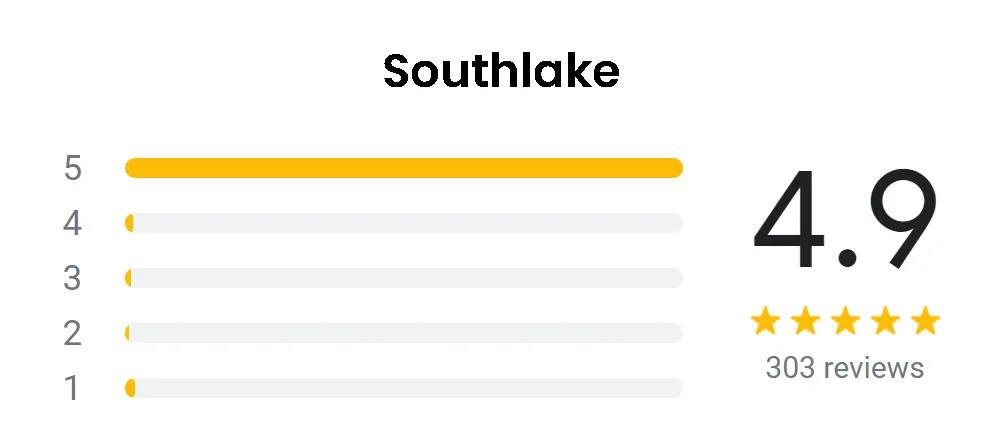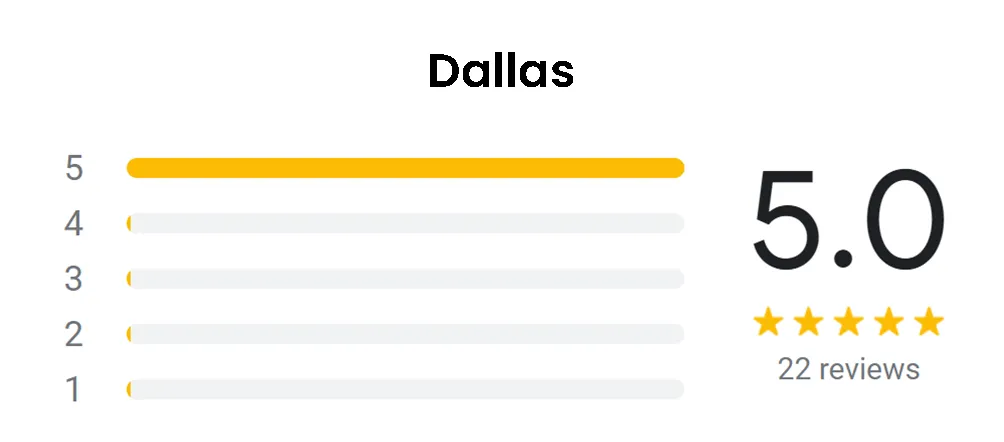
Flea larvae can be an unwelcome visitor in a dog's environment, posing significant concerns for pet owners. Identifying flea larvae on a dog is crucial because they can lead to infestations, discomfort, and potential health issues for the pet. Recognizing the signs of flea larvae early can help avoid bigger problems later.
Pet owners should understand that flea larvae thrive in various environments, often hidden in carpets, bedding, or even the grass outside. These larvae can easily latch onto a dog, which it's important to know how to recognize them. Proactive management and treatment options are available to eliminate both the larvae and adult fleas, ensuring the dog's well-being.
Understanding the lifecycle of fleas is key to effective prevention. By keeping all the spaces clean and applying the correct treatments, owners can significantly reduce the risk of flea larvae affecting their pets.
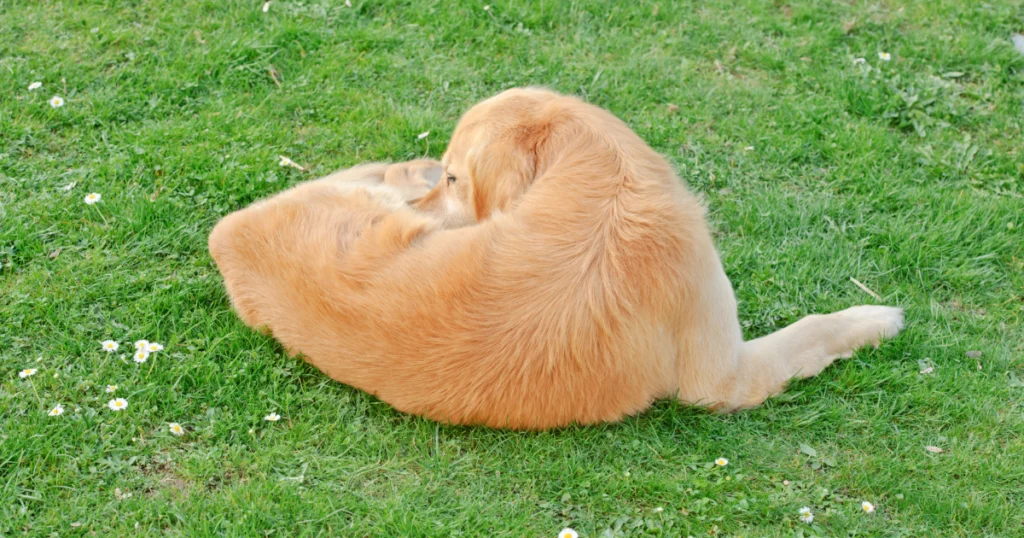
Fleas are a common issue for dogs, often leading to discomfort and health problems. Understanding their life cycle and how they infest dogs is key for successful control and prevention.
Fleas have a life cycle that divides in four stages: egg, larva, pupa, and adult. Adult fleas deposit up until 30 eggs a day, which fall off the host into the environment. These eggs hatch into larvae in about 1-10 days.
The larvae eats matter such as flea feces, which contains blood. After about 5-11 days, the larvae pupate. The stage where the flea is pupal lasts from as short as a few weeks to several months, depending on environmental conditions. Adult fleas come out when they feel vibrations or heat from a nearby host. This allows fleas to reproduce quickly, which is important to mention because it highlights the need for prompt treatment.
Fleas primarily infest dogs through direct contact with other infested animals or environments. They thrive in warm, humid conditions, making areas like carpets, bedding, and yards ideal breeding grounds.
An infested dog may exhibit signs such as excessive scratching, biting, or grooming. Fleas can spread diseases and trigger allergic reactions, resulting in skin infections and hair loss. Regularly checking and treating pets with flea prevention products helps reduce the likelihood of infestation. Early intervention is key to preventing adult fleas from establishing and multiplying.
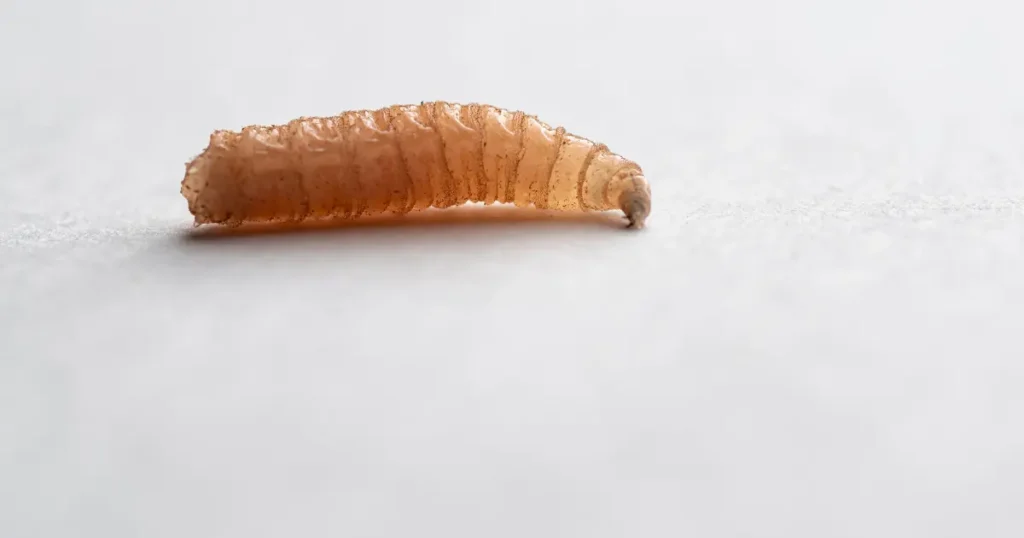
Recognizing flea larvae is essential for effective pest control. Understanding their appearance and how they differ from adult fleas can aid in swift identification and treatment.
Flea larvae measure about 2 to 5 millimeters in length. They are generally pale, with a whitish or translucent appearance, resembling small grains of rice. These larvae have a segmented body that may appear slightly wriggly.
They thrive in environments where adult fleas lay eggs. Flea larvae usually hide in bedding, carpets, or areas where pets spend time. On dogs, larvae may not be easily visible unless part of a larger infestation.
Flea larvae get their food from organic matter such as flea feces and skin flakes. It’s essential for pet owners to keep a close eye on their dogs to observe these signs because that’s how they can spot an infestation.
Differentiating between flea larvae and adult fleas is vital for accurate treatment. Adult fleas are much larger, averaging about 1.5 to 3.3 millimeters long with a flat, dark brown or black body.
Larvae, on the opposite, look more rounded and don’t have the distinctive wings and jumping ability of adults. Adult fleas are active and visible on the surface of the pet’s fur, while larvae typically remain hidden.
One way to spot adult fleas is by look at dirt that looks like tiny black dots on your dog's skin or fur. Identifying both life stages is essential for effectively eliminating fleas from the environment and the pet.
Flea larvae pose several risks to dogs and can lead to health concerns if not managed properly. It’s crucial for pet owners to constantly look for flea larvae in their dog feces and be aware of the diseases they can transmit.
Flea larvae often develop in the environment, including dog feces. When a dog infested with fleas poops, it can leave behind flea eggs and larvae. The larvae find comfort in conditions of warm and humidity. They can survive in yard debris or within home carpets. Pet owners may mistakenly believe their dog is free of fleas if they cannot see them.
Infestation Signs: Flea larvae themselves are not immediately harmful but an infestation does affect the dog’s skin as irritation, leading to itching and discomfort. It is essential to vacuum areas where the dog frequents and regularly doing yard maintenance to get rid of larvae.
While flea larvae do not directly transmit diseases, they are often associated with adult fleas that can carry pathogens. Adult fleas can transmit zoonotic diseases, impacting both dogs and humans.
Examples of diseases include:
Bartonellosis: Caused by Bartonella bacilliformis, this infection can lead to various symptoms, including fever and lethargy.
Tapeworms: Fleas can also be carriers of tapeworms, which may affect the dog’s health, leading to discomfort and digestive issues.
Additionally, flea infestations can lead to secondary infections from excessive scratching. Regular treatments and monitoring are vital in preventing these health risks.
Flea larvae can thrive in various environments, particularly where dogs spend a lot of time. Understanding their habitats is crucial for effective control and prevention measures.
Flea larvae often find homes in bed sheets, especially where pets frequently sleep. They prefer warm, dark places, making bedding an ideal environment.
These larvae feed on natural waste like skin flakes and hair. When the dog infests the bed, the shedding skin can feed the larvae.
To combat this issue, regular washing of bed sheets in hot water is essential. Vacuuming the bedding and surrounding areas will also help reduce their presence.
Additionally, using specially formulated insecticides designed for household use may assist in eliminating these pests.
Flea larvae can also infest clothing, particularly items stored in closets or piles where dogs tend to rest. Like bed sheets, fabrics provide a warm and protected environment, allowing larvae to thrive.
In homes with pets, it is common for clothing to collect fur and skin flakes, contributing to the larvae’s food supply. Objects on the floor or near infested pets are at greater risk.
To prevent infestation, individuals should wash clothing frequently in hot water and dry them thoroughly. Frequently vacuuming areas like closets and storage spaces can reduce the risk of larvae developing in clothes.
Additionally, using protective covers for clothing during peak flea season can be an effective preventative measure.
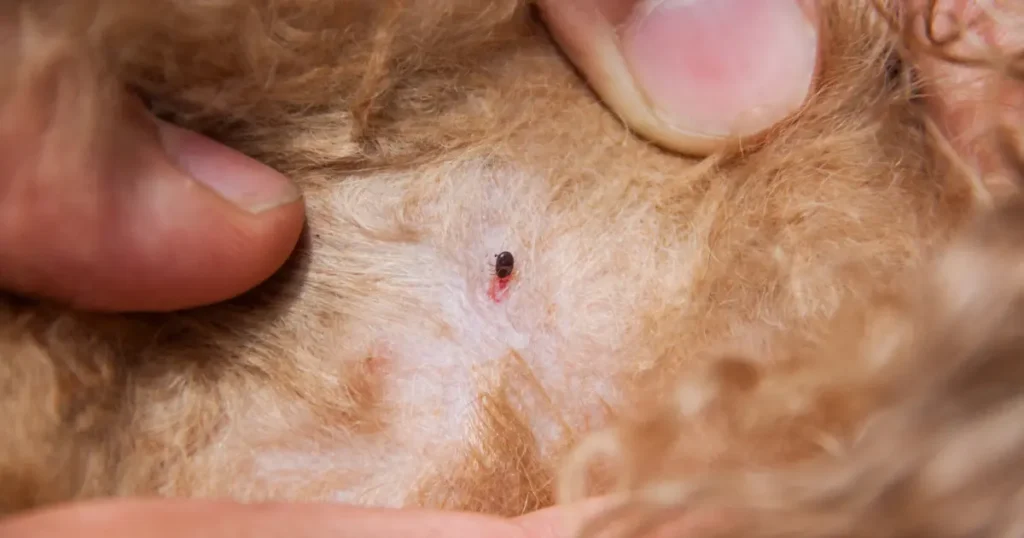
Effective prevention and management of flea larvae on dogs requires both proactive measures and environmental control. A comprehensive approach helps minimize the risks of infestations and ensures a healthier living space for pets.
To prevent flea larvae on dogs, regular grooming is essential. Frequent brushing helps remove existing fleas and their eggs from the coat. Bathing with flea-specific shampoos can also eliminate fleas, while topical treatments provide ongoing protection.
Using flea preventatives recommended by veterinarians can significantly reduce the risk of infestations. Oral medications, sprays, and collars are effective options. Choosing products with insect growth regulators (IGRs) can disrupt the flea lifecycle, especially targeting larvae.
Additionally, maintaining a clean environment is crucial. Regularly vacuuming rugs and upholstery removes flea eggs and larvae from those areas. Using hot water to wash pet bedding every 7 days further aids in controlling flea populations.
Flea larvae thrive in specific environments, making control essential. Keeping the home environment clean helps minimize infestations. Regularly vacuuming carpets, rugs, and furniture reduces the chances of larvae developing into adult fleas.
Outdoor areas should also be managed.Keeping the lawn mowed and free of debris reduces hiding spots for fleas.Treating outdoor spaces with flea control products can eliminate potential breeding sites.
Using diatomaceous earth in areas where pets play can help manage flea larvae. This natural substance dehydrates and kills larvae upon contact. Limitting areas where pets rest outdoors minimizes exposure to fleas, aiding in their overall management.
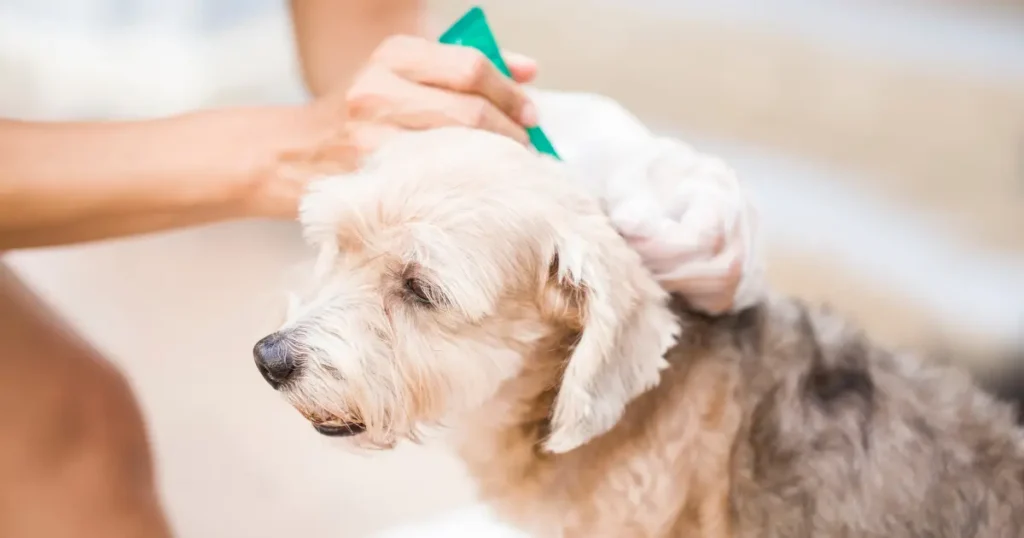
Effective treatment for flea larvae involves a combination of topical treatments, oral medications, and environmental treatments. Each approach targets different aspects of the flea life cycle, ensuring comprehensive management of the infestation.
Topical treatments are common for managing flea larvae in dogs. They are usually appliedon the pet’s skin. They work by killing adult fleas and preventing larvae from developing into adult stage.
Common options include:
Spot-on treatments: Applied between the shoulder blades, these can provide long-lasting protection.
Flea collars: These release chemicals that repel fleas and can kill those that come in contact.
It’s imperative to carefully follow the product instructions and speak to a veterinarian, as some products may not be suitable for all dogs, especially puppies or those with specific health concerns.
Oral medications offer a convenient way to treat flea infestations. They typically come in chewable form and can quickly disrupt the flea life cycle. These medications often contain insect growth regulators or adulticides.
Examples include:
Nitenpyram: Fastly eliminates adult fleas in a span of 30 minutes.
Lufenuron: Prevents the development of flea larvae by inhibiting chitin production.
Consulting a veterinarian is crucial to determining the best oral option, especially considering any potential side effects or interactions with other medications.
Addressing the environment is vital in preventing future flea infestations. Larvae can thrive in carpets, bedding, and yard areas. Environmental treatments include thorough cleaning and the use of insecticides.
Key measures include:
Vacuuming: Regular vacuuming removes eggs, larvae, and pupae from carpets and furniture.
Washing bedding: Wash with hot water every part of the pet bedding as well as any other material the pet frequents.
Insecticides: Use safe sprays or powders designed for flea larvae in home environments.
These steps, combined with treatments for the dog, create a comprehensive strategy to eliminate fleas effectively.
Effective cleaning and disinfection is crucial to eliminate flea larvae from a dog’s environment. This is done through the sanitization of the areas the pet lives and frequents as well as washing every potentially infested fabrics.
To effectively sanitize a dog's living area, focus on surfaces including floors, carpets, and bedding. Start with a thorough vacuuming to eliminae larvae and eggs. Give extra care to corners, under furniture and household items, and through cracks. Get rid of the vacuum contents right away to prevent any type of reinfestation.
For hard surfaces, clean those areas with either a blend of water and mild detergent or a solution of water and vinegar. Regularly clean dog bowls and toys as they can harbor flea eggs.
Recommended Cleaning Steps:
Washing Infested Fabrics
Washing fabrics that may be infested is vital. Bed sheets, dog blankets, and clothing should be cleaned in hot water. Set the washing machine to at least 130°F (54°C) to effectively eliminate flea larvae and eggs.
In addition to regular laundry detergent, adding a cup of white vinegar can enhance cleaning effectiveness. After washing, use high heat to dry the items as this helps eliminate any remaining eggs.
Use hot water setting for cleaning.
Include vinegar for extra effectiveness.
Dry on high heat for complete removal.
Regular cleaning and disinfection not only eliminate flea larvae but also contribute to an overall healthier environment for dogs and their owners.
After addressing flea larvae on a dog, continuous vigilance is crucial. Regular checks can prevent reinfestation, while long-term strategies help maintain a flea-free environment.
Flea activity must be monitored with routine inspections to prevent reinfestation. Dog owners should use a fine-toothed flea comb to examine their pets’ fur, especially around their neck and tail. This process can reveal adult fleas and flea dirt, indicators of an infestation.
In addition, checking common resting areas can provide insights into potential flea larvae. Owners should inspect bedding, carpets, and upholstered furniture. Constant vacuuming gets rid of flea eggs and larvae, reducing future outbreaks in these spaces. Immediate disposal of the vacuum bag or emptying the canister is recommended to prevent re-exposure.
Implementing effective prevention measures is pivotal for controlling flea populations. Regular application of veterinarian-recommended flea treatments such as skin medicine, oral treatments and flea collars can disrupt the flea life cycle.
Maintaining a clean environment is equally important. Washing dog bedding and frequently vacuuming living areas minimizes fleas and larvae. Regular yard maintenance, including lawn mowing and debris removal, contributes to an unfavorable environment for fleas.
Consider utilizing flea-repelling products around the home, such as diatomaceous earth or essential oil sprays. Combining these methods allows a well-rounded approach to flea prevention, ensuring long-term animal and household health.
Concerned about the health risks fleas pose to your pets and family? Contact us at Critter Stop for expert guidance on tackling flea larvae on your dog! We’re proud of our five-star reputation and positive online reviews, which reflect our commitment to quality work and exceptional customer service. Call us at (214) 234-2616 for a free inspection, and let us help you address any pest issues you’re facing!
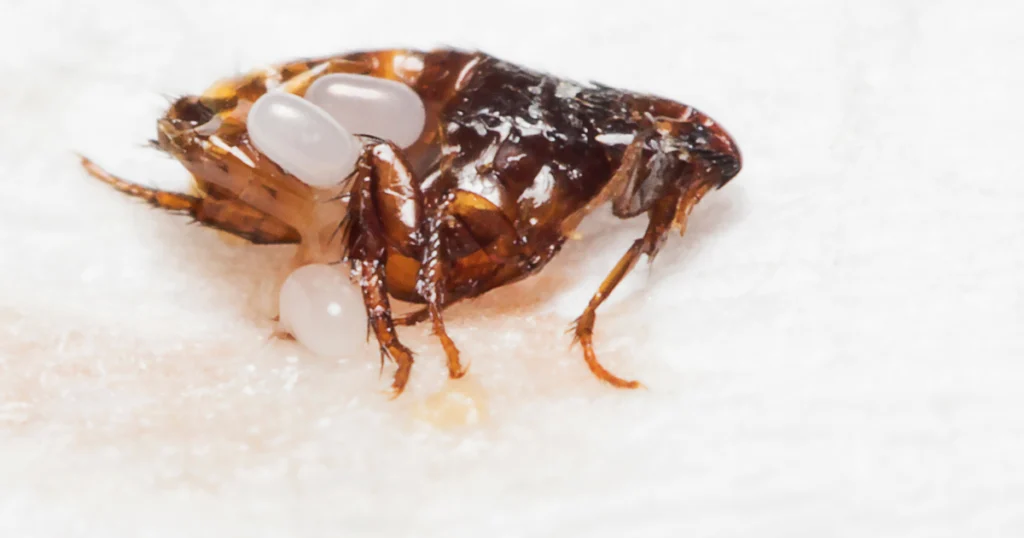
Flea larvae present a problem for dog owners that seek to maintain a pest-free environment. Understanding how to deal with flea larvae involves knowing what removal methods are effective and how to clearly spot the signs of an infestation.
Flea larvae on dogs are tiny, pale, and resemble small grains of rice. They are usually hidden in bedding or areas where pets spend time and may not be easily visible unless the infestation is large.
Simlar to dogs, flea larvae look similar on cats. They are small, white or translucent, and worm-like, measuring about 2-5 mm in length. The appearance doesn’t change significantly between species, but their distribution can vary depending on the grooming habits and environment where the pet resides in.
To eliminate flea larvae on dogs, regular bathing with a suitable flea shampoo is essential. Additionally, using flea combs can help physically remove larvae. It's crucial to take care of the dog's environment with treatment designed to kill fleas and larvae.
Natural methods for killing flea eggs and larvae include using diatomaceous earth, which dehydrates the pests. Essential oils, such as lavender or cedar oil, can also be effective when diluted and applied properly. Constant vacuuming and thoroughly washing pet bedding influence in disrupting the flea life cycle.
Many flea shampoos specifically target adult fleas, but some formulations may also kill larvae. It's important to carefully revise the product labels to follow the exact instructions and read about the efficacy. It may be necessary to repeat the treatments to reach a complete control.
Yes, the presence of flea larvae typically indicates a flea infestation. Adult fleas deposit eggs that turn into larvae, which thrive in pet bedding and carpets. Finding larvae suggests that preventive measures should be taken immediately.
Dead flea eggs are small, oval, and white or translucent in color. They are often about the size of a grain of salt. These eggs may be found in pet bedding, carpets, or close the areas where pets regularly spend their time.
Flea eggs are generally not black; they appear white or off-white. However, flea feces, known as "flea dirt," can be dark and could be confused with eggs. Identifying pests correctly is key for effective control.
Visit our Critter Library and learn more about our furry friends
